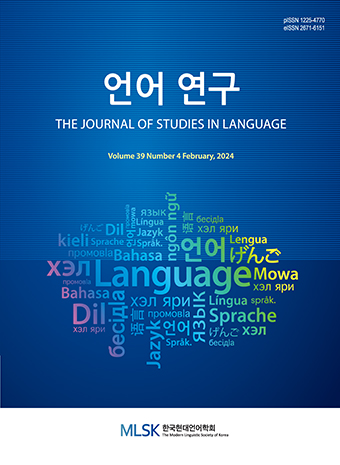Research Article
Abstract
References
Information
This study explores the correlation between degrees of coercion (i.e., resolution of semantic compatibility between a construction and a lexical item that occurs in the construction) and frequency of usage shown in Korean light verb construction (LVC) [NP(-ul) ha-] (‘do NP’). The usage-based model of grammar (Kemmer & Barlow, 2000; Langacker, 1988) assumes that linguistic knowledge is grounded in language use. Based on this assumption, the study observed contemporary spoken data of Sejong Corpus and obtained collostruction strength of the NPs occuring in the LVC. The study showed a correlation of the collostruction strength, acceptability judgments on the coerced LVC expressions used in Yoon (2019)'s study, and semantic compatibility obtained through theoretical observation. Moreover, the current study discusses how the lexical item, construction, and context interact for the coercion. With the empirical evidence, this study contributes to the research that investigates the relation of frequency in use and linguistic knowledge. It also demostrates actual usage of Korean LVC which has been mostly discussed from theoretical standpoints.
- 서정수. 1991. 『현대 한국어 문법 연구의 개관』. 서울: 한국문화사.
- 송정근. 2007. 구체명사와 결합하는 하다의 의미 특성에 대하여. 『한국어 의미학』 22, 123-140.
- 임서현. 2004. 생성어휘부 이론의 특질구조와 유형강제: 동사 ‘하-’를 중심으로. 『한국언어정보학회 하계학술대회 발표논문집』, 113-133.
- 임홍빈. 1979. 용언의 어근 분리 현상에 대하여. 『언어』 4.2, 55-76.
- Chae, H.-R. 1997. Verbal Nouns and Light Verbs in Korean. Language Research 33.4, 581-600.
- Choi, Y. J. 2014. Cognitive Semantics Approach to Korean Light Verb Constructions. The Journal of Linguistics Science 71, 355-372.
- Choi, Y. S. 2016. Verbal Noun in Korean Light Verb Construction Redux. The Journal of Studies in Language 32.1, 115-140. 10.18627/jslg.32.1.201605.115
- Im, S. and C. Lee. 2013. Combination of the Verb ha-‘do’ and Entity Type Nouns in Korean: A Generative Lexicon Approach. In J. Pustejovsky, P. Bouillon, H. Isahara, K. Kanzaki, and C. Lee (eds.), Advances in Generative Lexicon Theory. Dordrecht: Springer. 203-226. 10.1007/978-94-007-5189-7_9
- Joh, Y. 2018. Two Types of Korean Light Verb Constructions. The Mirae Journal of English Language and Literature 31.1, 1-22. 10.35771/engdoi.2018.31.1.010
- Jun, J. S. 2004. Enriched composition in conceptual semantics and the generative lexicon theory. Korean Journal of Linguistics 29.3, 437-460.
- Kearns, K. 1988. Light Verbs in English. Ms., MIT, Cambridge, Mass.
- Kemmer, S. and M. Barlow. 2000. Introduction: A Usage-based Conception of Language. In M. Barlow and S. Kemmer (eds.), Usage-based Models of Grammar. Stanford, CA: CSLI Publications, i-xxi.
- Kidd, E., E. V. M. Lieven, and M. Tomasello. 2010. Lexical frequency and Exemplar-based Learning Effects in Language Acquisition: Evidence from Sentential Complements. Language Sciences 32, 132-142. 10.1016/j.langsci.2009.05.002
- Kim, M. 2004. The Korean Verbal Nouns in Light Verb Constructions. The Journal of Modern British and American Language and Literature 22.3, 177-192.
- Langacker, R. W. 1988. A Usage-based Model. In B. Rudzke-Ostyn (ed.), Topics in Cognitive Linguistics. Amsterdam: Benjamins, 127-161. 10.1075/cilt.50.06lan
- Michaelis, L. A. 2005. Entity and event coercion in a symbolic theory of syntax. In J. Östman and M. Fried (eds.), Construction Grammars: Cognitive Grounding and Theoretical Extensions. Amsterdam; Philadelphia: John Benjamins Publishing Company, 45-88. 10.1075/cal.3.04mic
- Pak, M.-O. 1999. Verbal nouns in Korean: Categorically unspecified lexical roots. Harvard Studies in Koran Linguistics 8, 517-531.
- Pustejovsky, J. 1995. Linguistic Constraints on Type Coercion. In P. Saint-Dizier and E. Viegas (eds.), Computational Lexical Semantics. Cambridge; New York; Melbourne: Cambridge University Press. 71-97. 10.1017/CBO9780511527227.007
- Stefanowitsch, A. and S. Th. Gries. 2003. Collostructions: Investigating the Interaction of Words and Constructions. International Journal of Corpus Linguistics 8, 209-243. 10.1075/ijcl.8.2.03ste
- Tomasello, M. 2003. Constructing a Language: A Usage-based Theory of Language Acquisition. Cambridge, MA: Harvard University Press.
- Yoon, S. 2012. Constructions, Semantic Compatibility, and Coercion: An Empirical Usage-based Approach. Ph. D. Dissertation. Rice University.
- Yoon, S. 2013. Correlation between Semantic Compatibility and Frequency: A Usage-based Approach. Linguistic Research 30.2, 399-417. 10.17250/khisli.30.2.201308.005
- Yoon, S. 2019. Coercion and Language Change: A Usage-based Approach. Linguistic Research 36.1, 111-139.
- Publisher :The Modern Linguistic Society of Korea
- Publisher(Ko) :한국현대언어학회
- Journal Title :The Journal of Studies in Language
- Journal Title(Ko) :언어연구
- Volume : 37
- No :3
- Pages :317-334
- DOI :https://doi.org/10.18627/jslg.37.3.202111.317




 The Journal of Studies in Language
The Journal of Studies in Language






